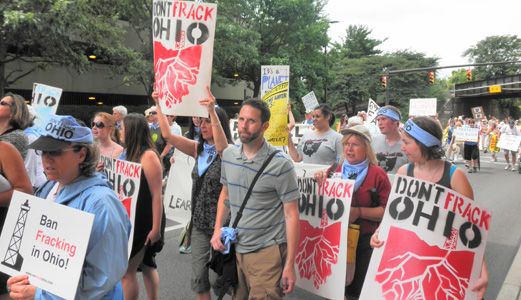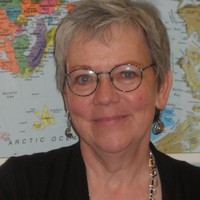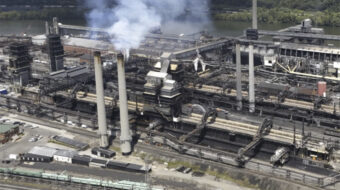
COLUMBUS, Ohio – Thousands rallied here June 17 to protest hydrofracking, or hydraulic fracturing, the destructive new process for gas extraction from underground shale beds. They marched to the statehouse and held a People’s Assembly to map a fight back against laws enacted by Republican Gov. John Kasich giving the industry a green light.
The rally culminated a three-day conference that brought together climate scientists, local and national activists and community leaders.
Despite stormy weather, the enthusiastic crowd gathered in Arch Park and donned blue bandanas with the slogan “Don’t Frack Ohio.”
Bill McKibben, the highly respected author and environmentalist, said action on climate issues is urgent because “the changes that are happening are so big and so dangerous.” May, he said, “was the 327th consecutive month that the global temperature was above the 20th century average. It was the warmest spring in this country that we’ve ever recorded.”
While applauding efforts to end fracking in Ohio, he said, “we need you to worry about more than just your own place, important as that is. Because we aren’t actually going to win the fight against global warming one pipeline and one frackwell at a time. We’re going to have to take on the fossil fuel industry.”
This means challenging the “special break” this industry currently enjoys – being allowed to emit its waste products – carbon – into the atmosphere of earth free of charge, he said. Also subsidies the U.S. government gives to the fossil fuel industry must end. Over the next decade, $113 billion in subsidies are slated to go to the richest industry on earth, he said.
McKibben said his group, 350.org, would be joining others later this week for Rio+20 Earth Summit. We are in the “symbolic company of people the world around,” he said.
“There are people who have the exact same thing in their hearts as you, a feeling for their place and a feeling for their future and it’s that feeling that we’ve got to turn into political power.”
The group’s name refers to the 350 parts per million that experts say is the safe upper limit for carbon dioxide in our atmosphere. The number currently stands at 380 parts per million.
350.org has a double meaning in Ohio, said Josh Fox, director of the film, Gasland.
“It stands for something else today too: $350,000 that the gas industry gave to your governor, to make sure that he’s not your governor anymore, to make sure that he’s the governor of the gas industry.”
Fox recalled when the gas industry first came to his door in Pennsylvania. Few people knew about fracking then and the industry was able to get away with a lot of misinformation. They promised windfall profits for landowners and minimal environmental consequences. Now people know that hydrofracking contaminates groundwater, pollutes the air, makes surrounding areas unlivable and storing the waste causes earthquakes.
The cash that the industry sends to politicians is like a symbolic fracking well, he said.
“$350,000 — that means that there’s a horizontal well bore going down from somewhere in the gas industry, snaking underneath the capital and injecting money up through the chamber. They’re fracking up your government.”
A bill passed last month opens up Ohio to more than 2,000 wells and allows companies to shield the chemicals they use in the fracking process from public scrutiny, as “trade secrets.” Fox called the legislation a “red carpet” for the gas industry.
Mary Clair Rietz of the Ohio Alliance for People and Environment said the legislation also takes away a local community’s right to prevent unwanted industrial activities. This has caused towns like Athens and Meyers Lake to use creative approaches to ban fracking as a violation of human rights to clean air and water.
Mansfield will hold a referendum in November to prevent fracking waste from being transported through the town. Rietz also recognized the handful of legislators who have stood up against the fossil fuel industry.
The crowd marched to the Ohio Statehouse and convened a People’s Assembly inside the rotunda. There, testimony was heard from people whose voices had been silenced in the legislature’s haste to welcome gas industry activities.
Allison Davis, a resident of Youngstown described the medical consequences she suffered from the fracking pollution in her area.
The assembly affirmed that Ohio’s residents and land should be protected from hydrofracking and smaller groups continued to meet on the statehouse lawns to plan future actions to reclaim community control and resist the devastation the gas industry is causing.
Photo: Marching to the Ohio statehouse to protest hydrofracking, June 17. Anita Waters/PW










